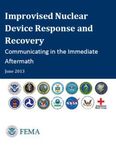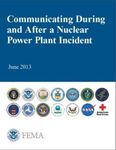CBRN and WMD Response: A Whole Community Approach The Role of FEMA - AUSA Conference
←
→
Page content transcription
If your browser does not render page correctly, please read the page content below
Mission Frameworks & FIOPS
The National Planning Frameworks The FIOPs are the Federal
outline how we will deliver what is government’s concept of operations
needed to achieve the National plans to execute the Frameworks. The
Preparedness Goal. The Frameworks: FIOPs contain:
Summarize roles and responsibilities An approach to integrating and synchronizing
Cover core capabilities federal capabilities
Define coordinating structures Description of critical tasks and
Describe the relationships between mission responsibilities
areas Specific provisions for the rapid integration of
Provide ideas for applying the Frameworks resources & personnel
Supersede existing incident annexes to the
National Response Framework (2007)
2DOD – FEMA Planning Integration
NORTHCOM Deputy J-55 (Plans Integration): A new FEMA detail began this summer at
NORAD/NORTHCOM to:
Enhance NORTHCOM integration with Regional federal interagency planning
Coordinate and standardize NORTHCOM Playbook development in support of federal regional
plans
NORTHCOM Playbooks (a.k.a. annexes to CONPLAN 3500): Playbooks are based on existing
Regional incident annexes pursuant to FEMA’s 5-year planning schedule.
The first are based on the Region IX Southern California Earthquake Plan and Region X Alaska
Annex
Upcoming Playbooks will address a Cascadia Subduction Zone earthquake, an IND response in
the National Capital Region, and a New Madrid Seismic Zone Earthquake
National Planning Integration Team (NPIT): Employed at least twice per Playbook engagement
between FEMA and DoD component planners to ensure planning assumptions, factors, and concepts
are nested with the regional federal interagency plan.
Crisis Action Planning: NORTHCOM is now accustomed to deploying an adjustable mix of planners to
FEMA to enable incident support efforts at the National Response Coordination Center.
“Maximum of Maximums”: All incidents – regardless of size or scope – are managed pursuant to the
National Response Framework, and Federal Interagency Operations Plan (FIOP) for Response and
Regional interagency plans to address the ‘maximum of maximum’ planning factors
3Ensuring Unique Capabilities
FEMA is required to develop and implement a risk-informed all-hazards strategy for
preparedness…while also building unique capabilities necessary to respond to specific
types of incidents that pose the greatest risk to our Nation. (6 U.S.C. 313)
Strategies define unique capability requirements for
Response and Recovery from CBRN incidents, as well as
identification of priority gap areas to inform future
priorities and investments.
Planning Guidance to inform the employment of unique
response and recovery strategies during CBRN incidents
to improve operational outcomes to save and sustain lives.
Operations Guidance to inform the unique application of
traditional and unique capabilities during CBRN incidents to
maximize the effectiveness of those capabilities within the
context of larger National response strategies
FEMA doctrine organizes incident management and
support efforts around common principles and common
operational design and conduct. Preserving the principles of
NIMS and ICS, FEMA produces authoritative operational
guidance operational guidance to support the conduct of
disaster operations.
5FEMA CBRNE Capabilities
Interagency Modeling and Atmospheric Assessment Center
(IMAAC): An interagency center responsible for production,
coordination, and dissemination of Federal consequence
predictions for an airborne hazardous material release. Managed
by DHS, other Federal partners include DOE, DOD, DOC
(NOAA), EPA, NASA, and NRC.
Nuclear Incident Response Team (NIRT): Specialized radiological
response teams managed day-to-day by the DOE/National Nuclear
Security Administration (NNSA) and the EPA. Operationally controlled
by FEMA when activated to provide expert technical advice and support
in disaster response operations and other needs involving nuclear
weapons incidents, and radiological incidents.
Domestic Emergency Support Team (DEST): A rapidly deployable
interagency team of experts from FEMA, DOE, HHS, EPA, FBI and DoD
to provide support to the FBI in response to a credible threat or incident.
FEMA is responsible for program management of the DEST as well co-
leading the team with FBI when deployed to coordinate pre-incident
consequence management activities.
6Exercise Coordination Opportunities
Build mutual comprehensive situational awareness of all exercise requirements across
FEMA and NORTHCOM components
Synchronize exercise schedules to leverage events to address priorities of mutual interest
Propose and shape exercise objectives, design, and location based on:
Plans ready for validation
New Policies (e.g., PPD-25), processes, and doctrine
Regions, States, and cities already engaged in topic
7You can also read



























































